2023小升初英语衔接句型专项练习(含答案及解析)
文档属性
| 名称 | 2023小升初英语衔接句型专项练习(含答案及解析) | 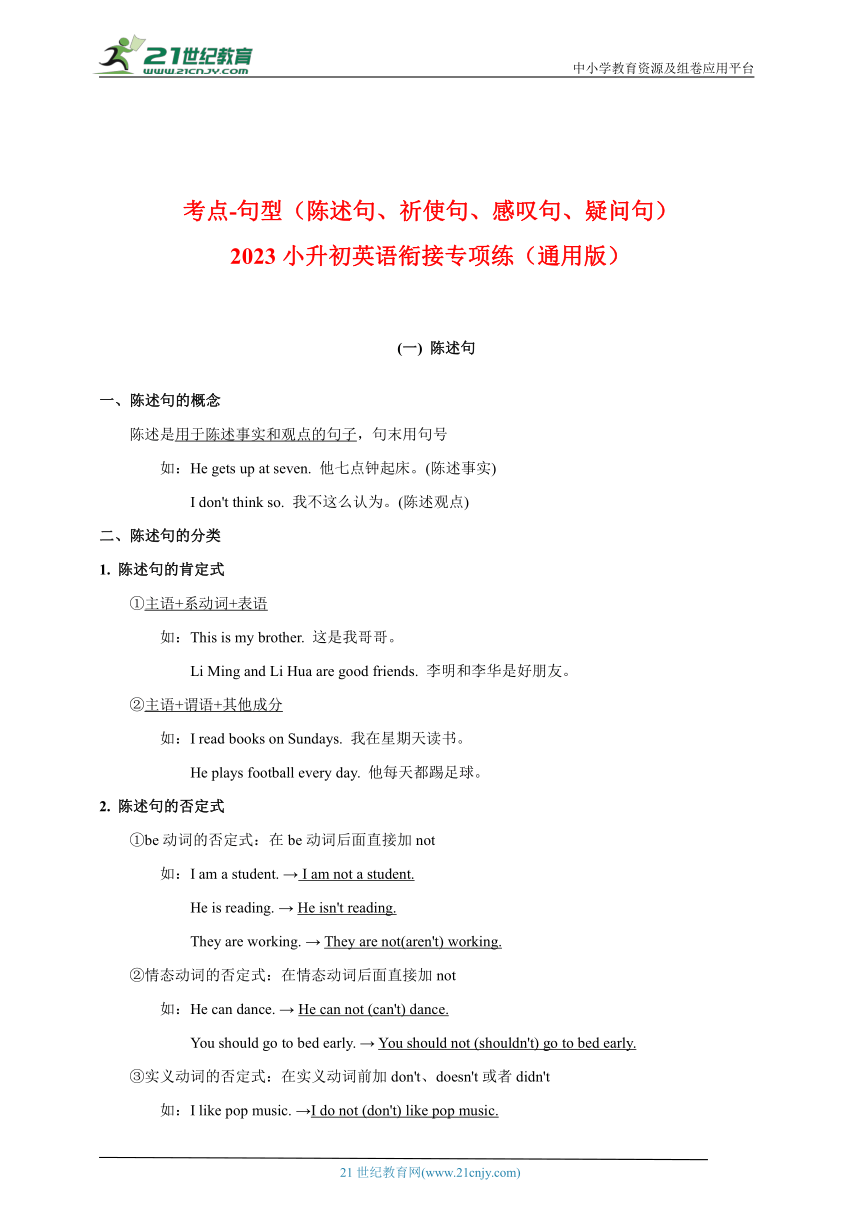 | |
| 格式 | doc | ||
| 文件大小 | 421.5KB | ||
| 资源类型 | 试卷 | ||
| 版本资源 | 人教新目标(Go for it)版 | ||
| 科目 | 英语 | ||
| 更新时间 | 2023-09-05 18:40:01 | ||
图片预览

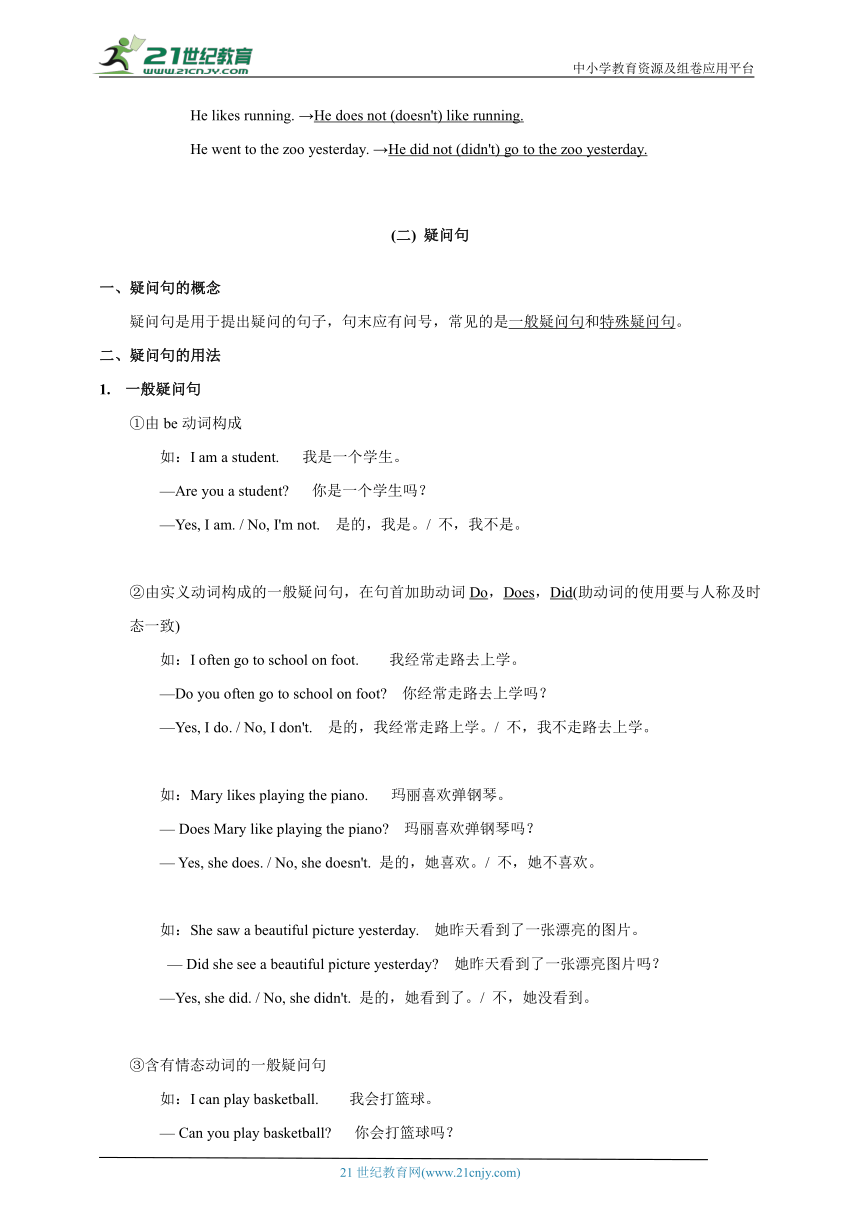
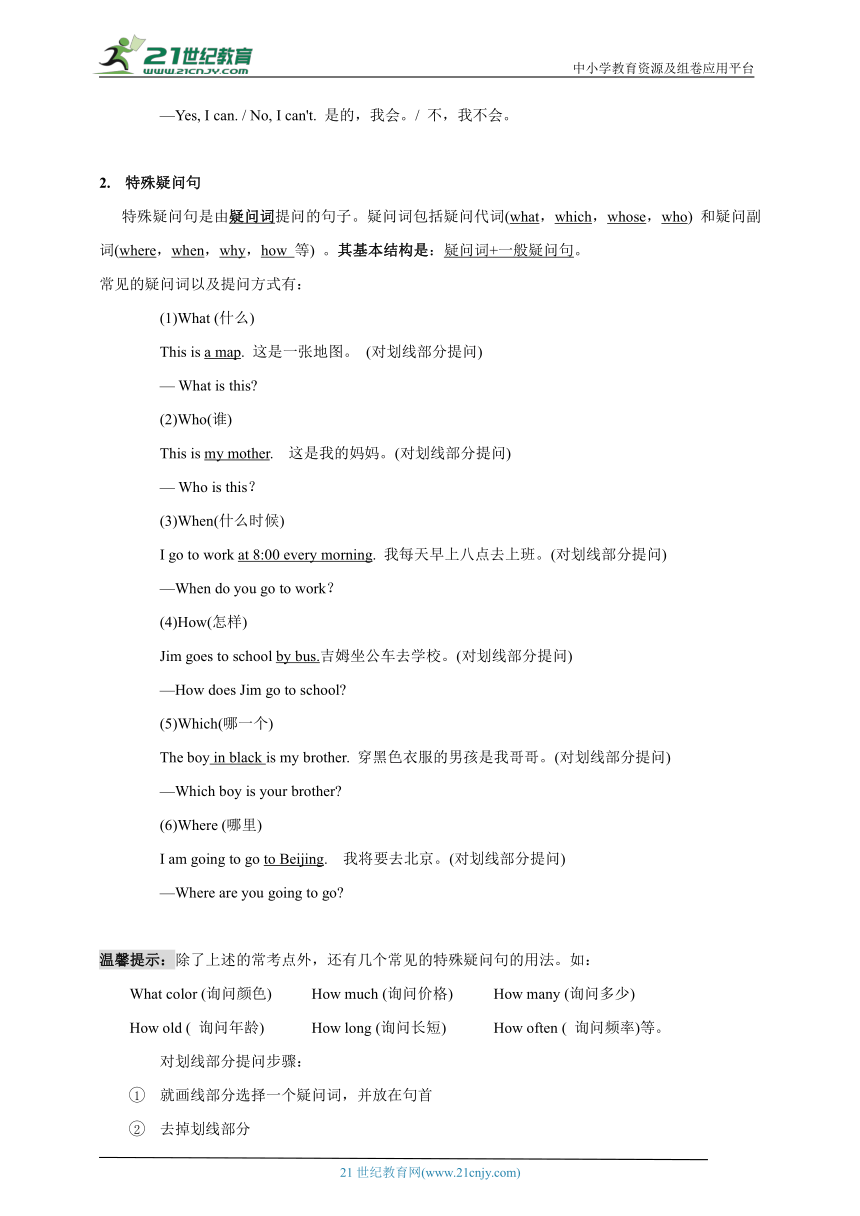
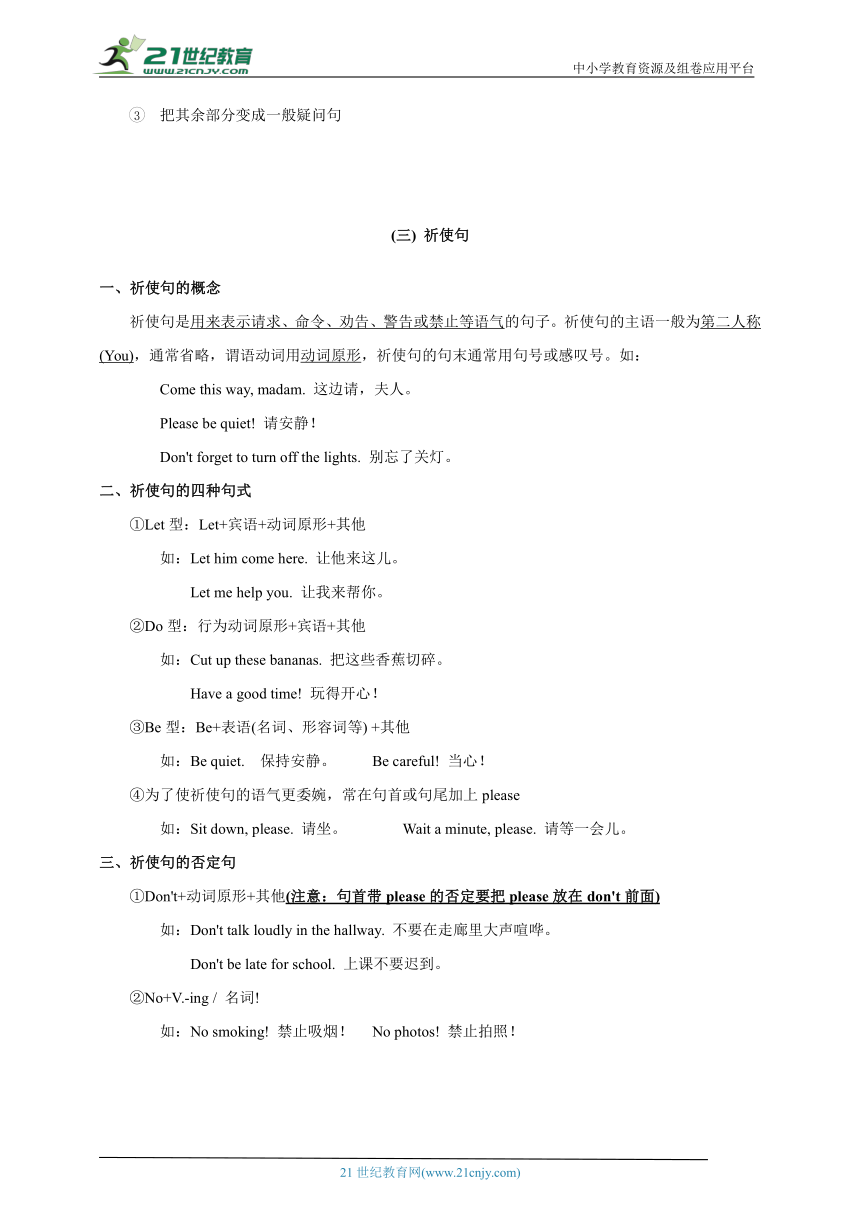
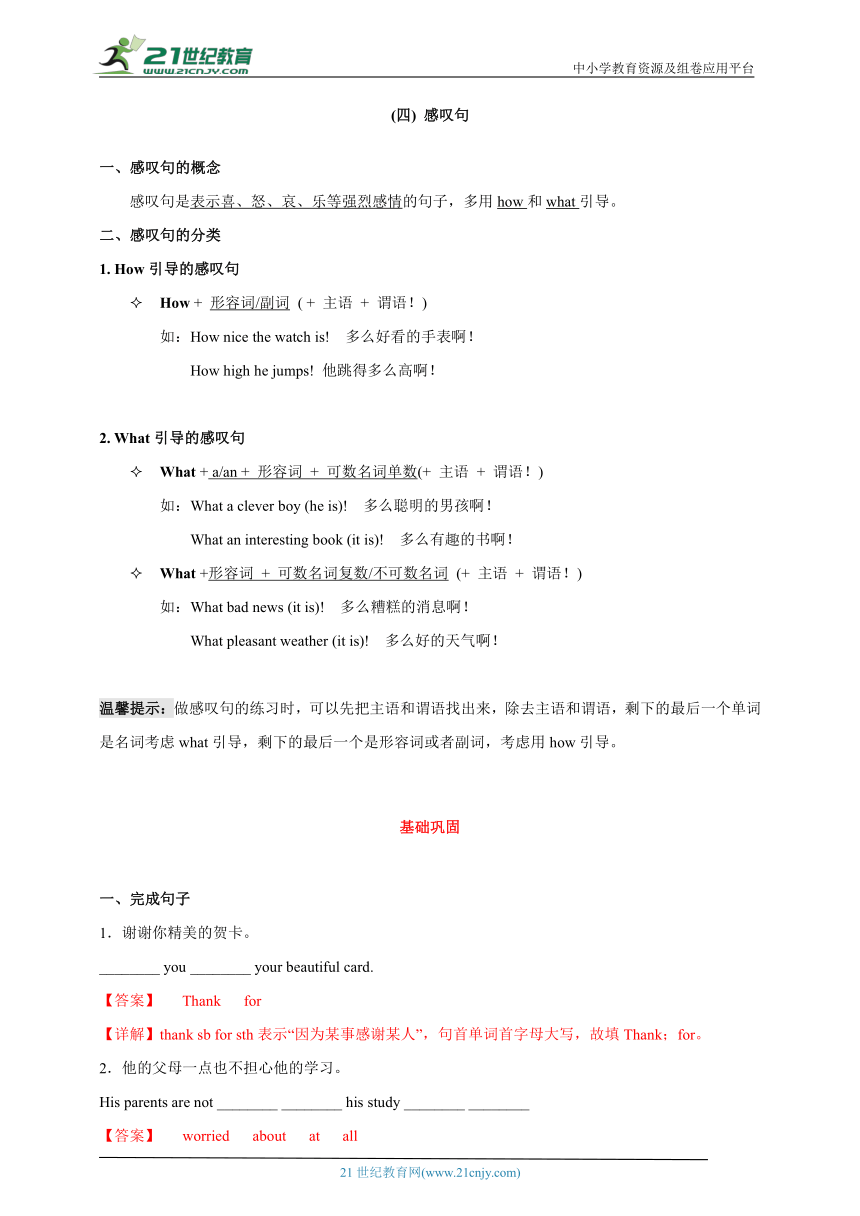
文档简介
中小学教育资源及组卷应用平台
考点-句型(陈述句、祈使句、感叹句、疑问句)
2023小升初英语衔接专项练(通用版)
(一) 陈述句
一、陈述句的概念
陈述是用于陈述事实和观点的句子,句末用句号
如:He gets up at seven. 他七点钟起床。(陈述事实)
I don't think so. 我不这么认为。(陈述观点)
二、陈述句的分类
1. 陈述句的肯定式
①主语+系动词+表语
如:This is my brother. 这是我哥哥。
Li Ming and Li Hua are good friends. 李明和李华是好朋友。
②主语+谓语+其他成分
如:I read books on Sundays. 我在星期天读书。
He plays football every day. 他每天都踢足球。
2. 陈述句的否定式
①be动词的否定式:在be动词后面直接加not
如:I am a student. → I am not a student.
He is reading. → He isn't reading.
They are working. → They are not(aren't) working.
②情态动词的否定式:在情态动词后面直接加not
如:He can dance. → He can not (can't) dance.
You should go to bed early. → You should not (shouldn't) go to bed early.
③实义动词的否定式:在实义动词前加don't、doesn't或者didn't
如:I like pop music. →I do not (don't) like pop music.
He likes running. →He does not (doesn't) like running.
He went to the zoo yesterday. →He did not (didn't) go to the zoo yesterday.
(二) 疑问句
一、疑问句的概念
疑问句是用于提出疑问的句子,句末应有问号,常见的是一般疑问句和特殊疑问句。
二、疑问句的用法
1. 一般疑问句
①由be动词构成
如:I am a student. 我是一个学生。
—Are you a student 你是一个学生吗?
—Yes, I am. / No, I'm not. 是的,我是。/ 不,我不是。
②由实义动词构成的一般疑问句,在句首加助动词Do,Does,Did(助动词的使用要与人称及时态一致)
如:I often go to school on foot. 我经常走路去上学。
—Do you often go to school on foot 你经常走路去上学吗?
—Yes, I do. / No, I don't. 是的,我经常走路上学。/ 不,我不走路去上学。
如:Mary likes playing the piano. 玛丽喜欢弹钢琴。
— Does Mary like playing the piano 玛丽喜欢弹钢琴吗?
— Yes, she does. / No, she doesn't. 是的,她喜欢。/ 不,她不喜欢。
如:She saw a beautiful picture yesterday. 她昨天看到了一张漂亮的图片。
— Did she see a beautiful picture yesterday 她昨天看到了一张漂亮图片吗?
—Yes, she did. / No, she didn't. 是的,她看到了。/ 不,她没看到。
③含有情态动词的一般疑问句
如:I can play basketball. 我会打篮球。
— Can you play basketball 你会打篮球吗?
—Yes, I can. / No, I can't. 是的,我会。/ 不,我不会。
2. 特殊疑问句
特殊疑问句是由疑问词提问的句子。疑问词包括疑问代词(what,which,whose,who) 和疑问副词(where,when,why,how 等) 。其基本结构是:疑问词+一般疑问句。
常见的疑问词以及提问方式有:
(1)What (什么)
This is a map. 这是一张地图。 (对划线部分提问)
— What is this
(2)Who(谁)
This is my mother. 这是我的妈妈。(对划线部分提问)
— Who is this?
(3)When(什么时候)
I go to work at 8:00 every morning. 我每天早上八点去上班。(对划线部分提问)
—When do you go to work?
(4)How(怎样)
Jim goes to school by bus.吉姆坐公车去学校。(对划线部分提问)
—How does Jim go to school
(5)Which(哪一个)
The boy in black is my brother. 穿黑色衣服的男孩是我哥哥。(对划线部分提问)
—Which boy is your brother
(6)Where (哪里)
I am going to go to Beijing. 我将要去北京。(对划线部分提问)
—Where are you going to go
温馨提示:除了上述的常考点外,还有几个常见的特殊疑问句的用法。如:
What color (询问颜色) How much (询问价格) How many (询问多少)
How old ( 询问年龄) How long (询问长短) How often ( 询问频率)等。
对划线部分提问步骤:
1 就画线部分选择一个疑问词,并放在句首
2 去掉划线部分
3 把其余部分变成一般疑问句
(三) 祈使句
一、祈使句的概念
祈使句是用来表示请求、命令、劝告、警告或禁止等语气的句子。祈使句的主语一般为第二人称(You),通常省略,谓语动词用动词原形,祈使句的句末通常用句号或感叹号。如:
Come this way, madam. 这边请,夫人。
Please be quiet! 请安静!
Don't forget to turn off the lights. 别忘了关灯。
二、祈使句的四种句式
①Let型:Let+宾语+动词原形+其他
如:Let him come here. 让他来这儿。
Let me help you. 让我来帮你。
②Do型:行为动词原形+宾语+其他
如:Cut up these bananas. 把这些香蕉切碎。
Have a good time! 玩得开心!
③Be型:Be+表语(名词、形容词等) +其他
如:Be quiet. 保持安静。 Be careful! 当心!
④为了使祈使句的语气更委婉,常在句首或句尾加上please
如:Sit down, please. 请坐。 Wait a minute, please. 请等一会儿。
三、祈使句的否定句
①Don't+动词原形+其他(注意:句首带please的否定要把please放在don't前面)
如:Don't talk loudly in the hallway. 不要在走廊里大声喧哗。
Don't be late for school. 上课不要迟到。
②No+V.-ing / 名词!
如:No smoking! 禁止吸烟! No photos! 禁止拍照!
(四) 感叹句
一、感叹句的概念
感叹句是表示喜、怒、哀、乐等强烈感情的句子,多用how和what引导。
二、感叹句的分类
1. How引导的感叹句
How + 形容词/副词 ( + 主语 + 谓语!)
如:How nice the watch is! 多么好看的手表啊!
How high he jumps! 他跳得多么高啊!
2. What引导的感叹句
What + a/an + 形容词 + 可数名词单数(+ 主语 + 谓语!)
如:What a clever boy (he is)! 多么聪明的男孩啊!
What an interesting book (it is)! 多么有趣的书啊!
What +形容词 + 可数名词复数/不可数名词 (+ 主语 + 谓语!)
如:What bad news (it is)! 多么糟糕的消息啊!
What pleasant weather (it is)! 多么好的天气啊!
温馨提示:做感叹句的练习时,可以先把主语和谓语找出来,除去主语和谓语,剩下的最后一个单词是名词考虑what引导,剩下的最后一个是形容词或者副词,考虑用how引导。
基础巩固
一、完成句子
1.谢谢你精美的贺卡。
________ you ________ your beautiful card.
【答案】 Thank for
【详解】thank sb for sth表示“因为某事感谢某人”,句首单词首字母大写,故填Thank;for。
2.他的父母一点也不担心他的学习。
His parents are not ________ ________ his study ________ ________
【答案】 worried about at all
【详解】“担心……”用系表结构是“be worried about”;“一点也不”对应的英文表达是“not...at all”,其中“at all”放在句子末尾。故填worried;about;at;all。
3.周六玛丽上两个小时美术课。(have)
Mary ___________________________________ on Saturday.
【答案】has an art lesson for two hours##has an art class for two hours
【详解】根据语境可知此句用的是一般现在时。上美术课:have an art lesson/class;两小时:for two hours。因为主语是“Mary”是第三人称单数,所以动词have要用动词三单has。故填has an art lesson/class for two hours。
4.贝蒂今天下午直到六点才到家。
Betty ________ ________ home ________ 6:00 this afternoon.
【答案】 didn’t get until
【详解】根据语境是一般过去时态的否定句,not...until...“直到……才……”,短语get home“到家”,变成否定句要借助助动词did+not+动词原形,故填didn’t;get;until。
5.当她经过时,她没有注意到我。
She didn’t ________ me when she passed by.
【答案】notice
【详解】根据中英文对照可知,空处缺少“注意到”,英文表达为“notice”,空前有“didn’t”,此处填动词原形。故填notice。
6.我也不能玩电子游戏。
I ______ play computer games, ________.
【答案】 can’t##cannot either
【详解】通过中英文句子对照可知,英文句子中需要翻译的部分是“不能”和“也”,“不能”英文表达用can’t/cannot,情态动词后接动词原形;“也”英文表达用either,用在否定句和疑问句中,放在句末;故填can’t/cannot;either。
7.我的爸爸忙于工作。他没有很多时间。
My father is busy with work. He doesn’t ________ ________ ________ ________ ________.
【答案】 have a lot of time
【详解】a lot of“许多”,修饰不可数名词time“时间”;have“有”,doesn’t后接动词原形,故填have;a;lot;of;time。
8.汤姆的房间不整洁,他的玩具到处都是。
Tom’s room isn’t tidy. __________________.
【答案】His toys are everywhere
【详解】根据汉语提示可知,空格处是陈述句,his toy他的玩具,根据语境,应该是用复数,his置于句首,首字母要大写,主语是复数,be动词用are,状语是everywhere。故填His toys are everywhere。
9.莉莉的铅笔盒只花了1美元。
Lily’s pencil box is ________ ________ ________.
【答案】 only 1##one dollar
【详解】由中英文对照可知,缺少“只花了1美元”。“1美元”1/one dollar;“只”only。故填only;1/one;dollar。
10.你现在不能见她,她正在打电话。
You can’t see her now. She is _______ _____________ ____________.
【答案】 on the phone
【详解】由汉语和所给的英语翻译可知,be on the phone意为“打电话”;故填on;the;phone。
拔高训练
二、改写句子
11.This is my pen. (改为一般疑问句)
________ this ________ pen
【答案】 Is your
【详解】句意:这是我的钢笔。改成一般疑问句表达“这是你的钢笔吗”;一般疑问句将be动词“is”放在主语“this”前,句首首字母大写;your“你的”,形容词性物主代词。故填Is;your。
12.Don’t forget to turn off the lights, please. (改为反意疑问句)
Don’t forget to turn off the lights, _____ _____
【答案】 will you
【详解】句意:请别忘了关灯。原句是“Don’t”开头的祈使句,反意疑问句是will you,故填will;you。
13.I can listen to music in class. (变为一般疑问句并做否定回答)
___________________________________________________________
【答案】—Can you listen to music in class —No, I can’t.
【详解】句意:我可以在课堂上听音乐。原句变为一般疑问句时,情态动词“can”要提前,位于句首,“I”变为“you”。“Can you…”句式的否定回答是“No, I can’t.”。故填—Can you listen to music in class —No, I can’t.
14.Jenny is watching the animals in the zoo.(改为一般疑问句)
________ Jenny ________ the animals in the zoo
【答案】 Is watching
【详解】句意:珍妮正在动物园里看动物。原句是现在进行时,变一般疑问句只需将助动词is提到主语之前即可,句首首字母大写。故填Is;watching。
15.There were some apples in the basket. (改为一般疑问句)
________ there ________ apples in the basket
【答案】 Were any
【详解】句意:篮子里有一些苹果。改为一般疑问句时be动词were置于句首,首字母大写;some改为any。故填Were;any。
16.Aunt Huang has tomatoes with eggs and rice for dinner. (改为一般疑问句,并作否定回答)
—_______ Aunt Huang _______ tomatoes with eggs and rice for dinner
—No, she ________.
【答案】 Does have doesn’t
【详解】句意:黄阿姨晚饭吃西红柿、鸡蛋和米饭。本句是含实义动词“has”的句子,主语是“Aunt Huang”,变一般疑问句时需借助助动词Does,其后需用动词“has”的原形have;其否定回答应是:No, she doesn’t。故填Does;have;doesn’t。
17.We had a great time last week. (改为一般疑问句)
________ ________ ________ a great time last week
【答案】 Did you have
【详解】句意:上周我们玩得很开心。根据题目要求和英文提示可知,原句中含有实意动词,时态是一般过去时,变疑问句要借助助动词did放在主语之前;第一人称we改为第二人称you;谓语动词成原形have;故填Did;you;have。
18.The teachers often tell the students not to be careless. (改为祈使句)
_____ _____ careless, please.
【答案】 Don’t be
【详解】句意:老师经常告诉学生不要粗心大意。分析句子可知句子时态是一般现在时,句子中有实义动词,变成祈使句需要使用助动词Don’t,后跟动词原形,表示“不要……”。故填Don’t;be。
19.Could you move the desk away, please (变祈使句)
___________________________________________________________.
【答案】Move the desk away, please##Please move the desk away
【详解】句意:请你把桌子挪开好吗?祈使句是动词原形开头,move是动词,意为“移动”,please意为“请”,可放在句首或者句末。故填Move the desk away, please/Please move the desk away。
20.Are these your cousins (作否定回答)
No, ________ ________.
【答案】 they aren’t
【详解】句意:这些是你的堂兄弟吗?“Are these”开头的一般疑问句,否定回答用No, they aren’t。故填they;aren’t。
21.Be early next time. (转换成否定的祈使同义句)
___________________________________________________________.
【答案】Don’t be late next time
【详解】句意:下次早点。原句是一个祈使句,祈使句变为否定句直接在句首加“Don’t”,此处要求改为意义相同的祈使句,因此把“early”换为“late”,表示“下次不要迟到”。故填Don’t be late next time。
22.You can’t park your car here. (变祈使句)
___________________________________________________________
【答案】Don’t park your car here.
【详解】句意:你不能把车停在这里。原句为否定句,故改为祈使句的否定形式,以don’t开头,后加动词原形。故填Don’t park your car here.
23.You cannot say anything too personal.(改为祈使句)
________ ________ anything too personal.
【答案】 Don’t say
【详解】句意:你不能说太隐私的话。原句中含有cannot是否定句,变为祈使句用don’t+动词原形形式。故填Don’t;say。
24.You can’t listen to music in the classroom. (改为祈使句)
__________ __________ to music in the classroom!
【答案】 Don’t listen
【详解】句意:你不能在教室里听音乐。根据“You can’t”可知要改为祈使句的否定形式,其结构为“Don’t+动词原形”。故填Don’t;listen。
25.You can’t arrive late for school. (改为祈使句)
________ ________ late for school.
【答案】 Don’t arrive
【详解】句意:你上学不要迟到。原句为否定的意思,祈使句的否定形式应在句首加Don’t,后面跟动词原形arrive“到达”。故填Don’t;arrive。
26.You can’t open the window. It’s cold outside. (改为祈使句)
________ ________ the window. It’s cold outside.
【答案】 Don’t open
【详解】句意:你不能打开窗户。外面很冷。分析句子可知,这是一个否定句,将其改为祈使句,需用Don’t+动词原形。故填Don’t;open。
27.They had a great time at the party yesterday. (改为感叹句)
________ ________ ________ ________ they had at the party yesterday!
【答案】 What a great time
【详解】句意:他们在昨天的聚会上玩得很开心。改为感叹句后句中缺少“a great time”,此处用“What a/an+形容词+可数名词单数+主谓+其他!”结构。故填What;a;great;time。
28.The girl is very brave and clever. (改为感叹句)
________ ________ and ________ the girl is!
【答案】 How brave clever
【详解】句意:这个女孩非常勇敢和聪明。根据题目要求可知,该句要改写成感叹句,中心词为形容词,使用的感叹句的句型是:How+形容词+主语+谓语,故填How;brave;clever。
29.If you want to get to the police station, please turn right at the third turning. (改为同义句)
If you want to get to the police station, please ________ the third turning ________ ________ ________.
【答案】 take on the right
【详解】句意:如果你想去警察局,请在第三个路口右转。根据原句可知,空格所在句为祈使句,take the+序数词+turning on the right=turn right at the+序数词+turning,表示“在第几个路口右转”,please后面跟动词原形。故填take;on;the;right。
30.My P.E class is on Monday.(就画线部分提问)
________ ________ your P.E. class
【答案】 When is
【详解】句意:我的体育课在周一。划线部分表示时间,用when提问,原句谓语动词是is,此处将is提到主语前。故填When;is。
31.The girl is very brave. (改为感叹句)
What _________ _________ _________ _________ _________!
How _________ _________ _________ _________!
【答案】 a brave girl she is brave the girl is
【详解】句意:这个女孩很勇敢。此题要求改为感叹句,感叹句是由what和how引导的;what引导的感叹句为:What (a/an)+形容词+名词+主语+谓语;how引导的感叹句为:How+形容词/副词+主语+谓语。这题的girl是单数名词,brave是形容词,且是以辅音音素开头的单词,前面用不定冠词a;所以这题的感叹句为:What a brave girl she is或How brave the girl is。故填a;brave;girl;she;is;brave;the;girl;is。
32.Millie runs very fast. (改为感叹句)
__________ _________ Millie runs!
【答案】 How fast
【详解】句意:米莉跑得非常快。根据题干可知,此处考查肯定句改为感叹句,根据转换后的题干“…Millie runs!”可推出,感叹句的中心词是副词“fast”,其前用“How”引导,首字母大写。故填How;fast。
33.It’s a nice present. (改为感叹句)
________ ________ nice present it is!
【答案】 What a
【详解】句意:这是一份很好的礼物。根据“nice present”可知,感叹句中强调名词。根据What+a/an+形容词+主谓可知,第一空填what,句首首字母大写;present“礼物”为单数,且是以辅音音素开头,应该用不定冠词a。故填What;a。
34.They are beautiful flowers.(改为感叹句)
________ ________ these flowers are!/________ ________ ________ they are!
【答案】 How beautiful What beautiful flowers
【详解】句意:它们是漂亮的花。分析句子结构可知,该句为:主语+系动词+表语;结合题干“these flowers are!”可知,感叹句句式应用:How+adj.+主语+谓语!;再根据题干“they are!”和句中含有名词复数“flowers”可知,感叹句还应用:What+形容词+可数名词复数+主语+谓语!。故填How;beautiful;What;beautiful;flowers。
35.His sister is a beautiful girl in our school.(变为感叹句)
_________ ________ beautiful girl his sister is in our school.
【答案】 What a
【详解】句意:他的姐姐是我们学校一个漂亮的女孩。根据空出的句子结构可知,应用what引导的感叹句,结构为:What+(a/an)+形容词+名词+主语+谓语!beautiful以辅音音素开头,使用冠词a,句首单词首字母大写,故填What;a。
36.This is a lazy grasshopper. (改为感叹句)
_________ _________ this grasshopper is!
【答案】 How lazy
【详解】句意:这是一只懒惰的蚱蜢。此处强调的中心词是形容词lazy,用“How+adj+主谓!”句型表示。故填How;lazy。
37.Sandy looks very beautiful.(改为感叹句)
________ ________ Sandy looks!
【答案】 How beautiful
【详解】句意:桑迪看起来很漂亮。多么美丽呀桑迪看起来!英语中的感叹句要由what和how来引导,其句型是:How+形容词/副词+主语+谓语+其他!以及What+(a/an)+名词+主语+谓语+其他!根据所给的单词beautiful是形容词,应用how来感叹形容词beautiful,故填(1). How (2). beautiful。
38.Yuan Longping was a great scientist. (改为感叹句)
______________________________________________!
【答案】How great a scientist Yuan Longping was/What a great scientist Yuan Longping was
【详解】句意:袁隆平是一位伟大的科学家。观察句子结构以及“a great scientist”可知,句子可用感叹词修饰“great”,符合how引导感叹句结构:How+形容词+a/an+可数名词单数+主语+谓语!此结构可与what 引导的感叹句:what+a/an+形容词+可数名词单数+主语+谓语!。故填How great a scientist Yuan Longping was/What a great scientist Yuan Longping was。
39.Daming and Mark are learning a lion dance.(就画线部分提问)
________ ________ Daming and Mark ________
【答案】 What are doing
【详解】句意:大明和马克正在学舞狮。画线部分是正在做的事情,就正在做的事情提问用what…doing,句首首字母w需要大写。原句是现在进行时态,疑问句是把be动词are提前。故填What;are;doing。
40.Please look after my pet well when I’m away. (改为同义句)
Please ________ ________ ________ ________ my pet when I’m away.
【答案】 take good care of
【详解】句意:我不在的时候,请照顾好我的宠物。look after...well=take good care of“照顾好”,用于祈使句中,使用动词原形。故填take;good;care;of。
21世纪教育网 www.21cnjy.com 精品试卷·第 2 页 (共 2 页)
HYPERLINK "http://21世纪教育网(www.21cnjy.com)
" 21世纪教育网(www.21cnjy.com)
考点-句型(陈述句、祈使句、感叹句、疑问句)
2023小升初英语衔接专项练(通用版)
(一) 陈述句
一、陈述句的概念
陈述是用于陈述事实和观点的句子,句末用句号
如:He gets up at seven. 他七点钟起床。(陈述事实)
I don't think so. 我不这么认为。(陈述观点)
二、陈述句的分类
1. 陈述句的肯定式
①主语+系动词+表语
如:This is my brother. 这是我哥哥。
Li Ming and Li Hua are good friends. 李明和李华是好朋友。
②主语+谓语+其他成分
如:I read books on Sundays. 我在星期天读书。
He plays football every day. 他每天都踢足球。
2. 陈述句的否定式
①be动词的否定式:在be动词后面直接加not
如:I am a student. → I am not a student.
He is reading. → He isn't reading.
They are working. → They are not(aren't) working.
②情态动词的否定式:在情态动词后面直接加not
如:He can dance. → He can not (can't) dance.
You should go to bed early. → You should not (shouldn't) go to bed early.
③实义动词的否定式:在实义动词前加don't、doesn't或者didn't
如:I like pop music. →I do not (don't) like pop music.
He likes running. →He does not (doesn't) like running.
He went to the zoo yesterday. →He did not (didn't) go to the zoo yesterday.
(二) 疑问句
一、疑问句的概念
疑问句是用于提出疑问的句子,句末应有问号,常见的是一般疑问句和特殊疑问句。
二、疑问句的用法
1. 一般疑问句
①由be动词构成
如:I am a student. 我是一个学生。
—Are you a student 你是一个学生吗?
—Yes, I am. / No, I'm not. 是的,我是。/ 不,我不是。
②由实义动词构成的一般疑问句,在句首加助动词Do,Does,Did(助动词的使用要与人称及时态一致)
如:I often go to school on foot. 我经常走路去上学。
—Do you often go to school on foot 你经常走路去上学吗?
—Yes, I do. / No, I don't. 是的,我经常走路上学。/ 不,我不走路去上学。
如:Mary likes playing the piano. 玛丽喜欢弹钢琴。
— Does Mary like playing the piano 玛丽喜欢弹钢琴吗?
— Yes, she does. / No, she doesn't. 是的,她喜欢。/ 不,她不喜欢。
如:She saw a beautiful picture yesterday. 她昨天看到了一张漂亮的图片。
— Did she see a beautiful picture yesterday 她昨天看到了一张漂亮图片吗?
—Yes, she did. / No, she didn't. 是的,她看到了。/ 不,她没看到。
③含有情态动词的一般疑问句
如:I can play basketball. 我会打篮球。
— Can you play basketball 你会打篮球吗?
—Yes, I can. / No, I can't. 是的,我会。/ 不,我不会。
2. 特殊疑问句
特殊疑问句是由疑问词提问的句子。疑问词包括疑问代词(what,which,whose,who) 和疑问副词(where,when,why,how 等) 。其基本结构是:疑问词+一般疑问句。
常见的疑问词以及提问方式有:
(1)What (什么)
This is a map. 这是一张地图。 (对划线部分提问)
— What is this
(2)Who(谁)
This is my mother. 这是我的妈妈。(对划线部分提问)
— Who is this?
(3)When(什么时候)
I go to work at 8:00 every morning. 我每天早上八点去上班。(对划线部分提问)
—When do you go to work?
(4)How(怎样)
Jim goes to school by bus.吉姆坐公车去学校。(对划线部分提问)
—How does Jim go to school
(5)Which(哪一个)
The boy in black is my brother. 穿黑色衣服的男孩是我哥哥。(对划线部分提问)
—Which boy is your brother
(6)Where (哪里)
I am going to go to Beijing. 我将要去北京。(对划线部分提问)
—Where are you going to go
温馨提示:除了上述的常考点外,还有几个常见的特殊疑问句的用法。如:
What color (询问颜色) How much (询问价格) How many (询问多少)
How old ( 询问年龄) How long (询问长短) How often ( 询问频率)等。
对划线部分提问步骤:
1 就画线部分选择一个疑问词,并放在句首
2 去掉划线部分
3 把其余部分变成一般疑问句
(三) 祈使句
一、祈使句的概念
祈使句是用来表示请求、命令、劝告、警告或禁止等语气的句子。祈使句的主语一般为第二人称(You),通常省略,谓语动词用动词原形,祈使句的句末通常用句号或感叹号。如:
Come this way, madam. 这边请,夫人。
Please be quiet! 请安静!
Don't forget to turn off the lights. 别忘了关灯。
二、祈使句的四种句式
①Let型:Let+宾语+动词原形+其他
如:Let him come here. 让他来这儿。
Let me help you. 让我来帮你。
②Do型:行为动词原形+宾语+其他
如:Cut up these bananas. 把这些香蕉切碎。
Have a good time! 玩得开心!
③Be型:Be+表语(名词、形容词等) +其他
如:Be quiet. 保持安静。 Be careful! 当心!
④为了使祈使句的语气更委婉,常在句首或句尾加上please
如:Sit down, please. 请坐。 Wait a minute, please. 请等一会儿。
三、祈使句的否定句
①Don't+动词原形+其他(注意:句首带please的否定要把please放在don't前面)
如:Don't talk loudly in the hallway. 不要在走廊里大声喧哗。
Don't be late for school. 上课不要迟到。
②No+V.-ing / 名词!
如:No smoking! 禁止吸烟! No photos! 禁止拍照!
(四) 感叹句
一、感叹句的概念
感叹句是表示喜、怒、哀、乐等强烈感情的句子,多用how和what引导。
二、感叹句的分类
1. How引导的感叹句
How + 形容词/副词 ( + 主语 + 谓语!)
如:How nice the watch is! 多么好看的手表啊!
How high he jumps! 他跳得多么高啊!
2. What引导的感叹句
What + a/an + 形容词 + 可数名词单数(+ 主语 + 谓语!)
如:What a clever boy (he is)! 多么聪明的男孩啊!
What an interesting book (it is)! 多么有趣的书啊!
What +形容词 + 可数名词复数/不可数名词 (+ 主语 + 谓语!)
如:What bad news (it is)! 多么糟糕的消息啊!
What pleasant weather (it is)! 多么好的天气啊!
温馨提示:做感叹句的练习时,可以先把主语和谓语找出来,除去主语和谓语,剩下的最后一个单词是名词考虑what引导,剩下的最后一个是形容词或者副词,考虑用how引导。
基础巩固
一、完成句子
1.谢谢你精美的贺卡。
________ you ________ your beautiful card.
【答案】 Thank for
【详解】thank sb for sth表示“因为某事感谢某人”,句首单词首字母大写,故填Thank;for。
2.他的父母一点也不担心他的学习。
His parents are not ________ ________ his study ________ ________
【答案】 worried about at all
【详解】“担心……”用系表结构是“be worried about”;“一点也不”对应的英文表达是“not...at all”,其中“at all”放在句子末尾。故填worried;about;at;all。
3.周六玛丽上两个小时美术课。(have)
Mary ___________________________________ on Saturday.
【答案】has an art lesson for two hours##has an art class for two hours
【详解】根据语境可知此句用的是一般现在时。上美术课:have an art lesson/class;两小时:for two hours。因为主语是“Mary”是第三人称单数,所以动词have要用动词三单has。故填has an art lesson/class for two hours。
4.贝蒂今天下午直到六点才到家。
Betty ________ ________ home ________ 6:00 this afternoon.
【答案】 didn’t get until
【详解】根据语境是一般过去时态的否定句,not...until...“直到……才……”,短语get home“到家”,变成否定句要借助助动词did+not+动词原形,故填didn’t;get;until。
5.当她经过时,她没有注意到我。
She didn’t ________ me when she passed by.
【答案】notice
【详解】根据中英文对照可知,空处缺少“注意到”,英文表达为“notice”,空前有“didn’t”,此处填动词原形。故填notice。
6.我也不能玩电子游戏。
I ______ play computer games, ________.
【答案】 can’t##cannot either
【详解】通过中英文句子对照可知,英文句子中需要翻译的部分是“不能”和“也”,“不能”英文表达用can’t/cannot,情态动词后接动词原形;“也”英文表达用either,用在否定句和疑问句中,放在句末;故填can’t/cannot;either。
7.我的爸爸忙于工作。他没有很多时间。
My father is busy with work. He doesn’t ________ ________ ________ ________ ________.
【答案】 have a lot of time
【详解】a lot of“许多”,修饰不可数名词time“时间”;have“有”,doesn’t后接动词原形,故填have;a;lot;of;time。
8.汤姆的房间不整洁,他的玩具到处都是。
Tom’s room isn’t tidy. __________________.
【答案】His toys are everywhere
【详解】根据汉语提示可知,空格处是陈述句,his toy他的玩具,根据语境,应该是用复数,his置于句首,首字母要大写,主语是复数,be动词用are,状语是everywhere。故填His toys are everywhere。
9.莉莉的铅笔盒只花了1美元。
Lily’s pencil box is ________ ________ ________.
【答案】 only 1##one dollar
【详解】由中英文对照可知,缺少“只花了1美元”。“1美元”1/one dollar;“只”only。故填only;1/one;dollar。
10.你现在不能见她,她正在打电话。
You can’t see her now. She is _______ _____________ ____________.
【答案】 on the phone
【详解】由汉语和所给的英语翻译可知,be on the phone意为“打电话”;故填on;the;phone。
拔高训练
二、改写句子
11.This is my pen. (改为一般疑问句)
________ this ________ pen
【答案】 Is your
【详解】句意:这是我的钢笔。改成一般疑问句表达“这是你的钢笔吗”;一般疑问句将be动词“is”放在主语“this”前,句首首字母大写;your“你的”,形容词性物主代词。故填Is;your。
12.Don’t forget to turn off the lights, please. (改为反意疑问句)
Don’t forget to turn off the lights, _____ _____
【答案】 will you
【详解】句意:请别忘了关灯。原句是“Don’t”开头的祈使句,反意疑问句是will you,故填will;you。
13.I can listen to music in class. (变为一般疑问句并做否定回答)
___________________________________________________________
【答案】—Can you listen to music in class —No, I can’t.
【详解】句意:我可以在课堂上听音乐。原句变为一般疑问句时,情态动词“can”要提前,位于句首,“I”变为“you”。“Can you…”句式的否定回答是“No, I can’t.”。故填—Can you listen to music in class —No, I can’t.
14.Jenny is watching the animals in the zoo.(改为一般疑问句)
________ Jenny ________ the animals in the zoo
【答案】 Is watching
【详解】句意:珍妮正在动物园里看动物。原句是现在进行时,变一般疑问句只需将助动词is提到主语之前即可,句首首字母大写。故填Is;watching。
15.There were some apples in the basket. (改为一般疑问句)
________ there ________ apples in the basket
【答案】 Were any
【详解】句意:篮子里有一些苹果。改为一般疑问句时be动词were置于句首,首字母大写;some改为any。故填Were;any。
16.Aunt Huang has tomatoes with eggs and rice for dinner. (改为一般疑问句,并作否定回答)
—_______ Aunt Huang _______ tomatoes with eggs and rice for dinner
—No, she ________.
【答案】 Does have doesn’t
【详解】句意:黄阿姨晚饭吃西红柿、鸡蛋和米饭。本句是含实义动词“has”的句子,主语是“Aunt Huang”,变一般疑问句时需借助助动词Does,其后需用动词“has”的原形have;其否定回答应是:No, she doesn’t。故填Does;have;doesn’t。
17.We had a great time last week. (改为一般疑问句)
________ ________ ________ a great time last week
【答案】 Did you have
【详解】句意:上周我们玩得很开心。根据题目要求和英文提示可知,原句中含有实意动词,时态是一般过去时,变疑问句要借助助动词did放在主语之前;第一人称we改为第二人称you;谓语动词成原形have;故填Did;you;have。
18.The teachers often tell the students not to be careless. (改为祈使句)
_____ _____ careless, please.
【答案】 Don’t be
【详解】句意:老师经常告诉学生不要粗心大意。分析句子可知句子时态是一般现在时,句子中有实义动词,变成祈使句需要使用助动词Don’t,后跟动词原形,表示“不要……”。故填Don’t;be。
19.Could you move the desk away, please (变祈使句)
___________________________________________________________.
【答案】Move the desk away, please##Please move the desk away
【详解】句意:请你把桌子挪开好吗?祈使句是动词原形开头,move是动词,意为“移动”,please意为“请”,可放在句首或者句末。故填Move the desk away, please/Please move the desk away。
20.Are these your cousins (作否定回答)
No, ________ ________.
【答案】 they aren’t
【详解】句意:这些是你的堂兄弟吗?“Are these”开头的一般疑问句,否定回答用No, they aren’t。故填they;aren’t。
21.Be early next time. (转换成否定的祈使同义句)
___________________________________________________________.
【答案】Don’t be late next time
【详解】句意:下次早点。原句是一个祈使句,祈使句变为否定句直接在句首加“Don’t”,此处要求改为意义相同的祈使句,因此把“early”换为“late”,表示“下次不要迟到”。故填Don’t be late next time。
22.You can’t park your car here. (变祈使句)
___________________________________________________________
【答案】Don’t park your car here.
【详解】句意:你不能把车停在这里。原句为否定句,故改为祈使句的否定形式,以don’t开头,后加动词原形。故填Don’t park your car here.
23.You cannot say anything too personal.(改为祈使句)
________ ________ anything too personal.
【答案】 Don’t say
【详解】句意:你不能说太隐私的话。原句中含有cannot是否定句,变为祈使句用don’t+动词原形形式。故填Don’t;say。
24.You can’t listen to music in the classroom. (改为祈使句)
__________ __________ to music in the classroom!
【答案】 Don’t listen
【详解】句意:你不能在教室里听音乐。根据“You can’t”可知要改为祈使句的否定形式,其结构为“Don’t+动词原形”。故填Don’t;listen。
25.You can’t arrive late for school. (改为祈使句)
________ ________ late for school.
【答案】 Don’t arrive
【详解】句意:你上学不要迟到。原句为否定的意思,祈使句的否定形式应在句首加Don’t,后面跟动词原形arrive“到达”。故填Don’t;arrive。
26.You can’t open the window. It’s cold outside. (改为祈使句)
________ ________ the window. It’s cold outside.
【答案】 Don’t open
【详解】句意:你不能打开窗户。外面很冷。分析句子可知,这是一个否定句,将其改为祈使句,需用Don’t+动词原形。故填Don’t;open。
27.They had a great time at the party yesterday. (改为感叹句)
________ ________ ________ ________ they had at the party yesterday!
【答案】 What a great time
【详解】句意:他们在昨天的聚会上玩得很开心。改为感叹句后句中缺少“a great time”,此处用“What a/an+形容词+可数名词单数+主谓+其他!”结构。故填What;a;great;time。
28.The girl is very brave and clever. (改为感叹句)
________ ________ and ________ the girl is!
【答案】 How brave clever
【详解】句意:这个女孩非常勇敢和聪明。根据题目要求可知,该句要改写成感叹句,中心词为形容词,使用的感叹句的句型是:How+形容词+主语+谓语,故填How;brave;clever。
29.If you want to get to the police station, please turn right at the third turning. (改为同义句)
If you want to get to the police station, please ________ the third turning ________ ________ ________.
【答案】 take on the right
【详解】句意:如果你想去警察局,请在第三个路口右转。根据原句可知,空格所在句为祈使句,take the+序数词+turning on the right=turn right at the+序数词+turning,表示“在第几个路口右转”,please后面跟动词原形。故填take;on;the;right。
30.My P.E class is on Monday.(就画线部分提问)
________ ________ your P.E. class
【答案】 When is
【详解】句意:我的体育课在周一。划线部分表示时间,用when提问,原句谓语动词是is,此处将is提到主语前。故填When;is。
31.The girl is very brave. (改为感叹句)
What _________ _________ _________ _________ _________!
How _________ _________ _________ _________!
【答案】 a brave girl she is brave the girl is
【详解】句意:这个女孩很勇敢。此题要求改为感叹句,感叹句是由what和how引导的;what引导的感叹句为:What (a/an)+形容词+名词+主语+谓语;how引导的感叹句为:How+形容词/副词+主语+谓语。这题的girl是单数名词,brave是形容词,且是以辅音音素开头的单词,前面用不定冠词a;所以这题的感叹句为:What a brave girl she is或How brave the girl is。故填a;brave;girl;she;is;brave;the;girl;is。
32.Millie runs very fast. (改为感叹句)
__________ _________ Millie runs!
【答案】 How fast
【详解】句意:米莉跑得非常快。根据题干可知,此处考查肯定句改为感叹句,根据转换后的题干“…Millie runs!”可推出,感叹句的中心词是副词“fast”,其前用“How”引导,首字母大写。故填How;fast。
33.It’s a nice present. (改为感叹句)
________ ________ nice present it is!
【答案】 What a
【详解】句意:这是一份很好的礼物。根据“nice present”可知,感叹句中强调名词。根据What+a/an+形容词+主谓可知,第一空填what,句首首字母大写;present“礼物”为单数,且是以辅音音素开头,应该用不定冠词a。故填What;a。
34.They are beautiful flowers.(改为感叹句)
________ ________ these flowers are!/________ ________ ________ they are!
【答案】 How beautiful What beautiful flowers
【详解】句意:它们是漂亮的花。分析句子结构可知,该句为:主语+系动词+表语;结合题干“these flowers are!”可知,感叹句句式应用:How+adj.+主语+谓语!;再根据题干“they are!”和句中含有名词复数“flowers”可知,感叹句还应用:What+形容词+可数名词复数+主语+谓语!。故填How;beautiful;What;beautiful;flowers。
35.His sister is a beautiful girl in our school.(变为感叹句)
_________ ________ beautiful girl his sister is in our school.
【答案】 What a
【详解】句意:他的姐姐是我们学校一个漂亮的女孩。根据空出的句子结构可知,应用what引导的感叹句,结构为:What+(a/an)+形容词+名词+主语+谓语!beautiful以辅音音素开头,使用冠词a,句首单词首字母大写,故填What;a。
36.This is a lazy grasshopper. (改为感叹句)
_________ _________ this grasshopper is!
【答案】 How lazy
【详解】句意:这是一只懒惰的蚱蜢。此处强调的中心词是形容词lazy,用“How+adj+主谓!”句型表示。故填How;lazy。
37.Sandy looks very beautiful.(改为感叹句)
________ ________ Sandy looks!
【答案】 How beautiful
【详解】句意:桑迪看起来很漂亮。多么美丽呀桑迪看起来!英语中的感叹句要由what和how来引导,其句型是:How+形容词/副词+主语+谓语+其他!以及What+(a/an)+名词+主语+谓语+其他!根据所给的单词beautiful是形容词,应用how来感叹形容词beautiful,故填(1). How (2). beautiful。
38.Yuan Longping was a great scientist. (改为感叹句)
______________________________________________!
【答案】How great a scientist Yuan Longping was/What a great scientist Yuan Longping was
【详解】句意:袁隆平是一位伟大的科学家。观察句子结构以及“a great scientist”可知,句子可用感叹词修饰“great”,符合how引导感叹句结构:How+形容词+a/an+可数名词单数+主语+谓语!此结构可与what 引导的感叹句:what+a/an+形容词+可数名词单数+主语+谓语!。故填How great a scientist Yuan Longping was/What a great scientist Yuan Longping was。
39.Daming and Mark are learning a lion dance.(就画线部分提问)
________ ________ Daming and Mark ________
【答案】 What are doing
【详解】句意:大明和马克正在学舞狮。画线部分是正在做的事情,就正在做的事情提问用what…doing,句首首字母w需要大写。原句是现在进行时态,疑问句是把be动词are提前。故填What;are;doing。
40.Please look after my pet well when I’m away. (改为同义句)
Please ________ ________ ________ ________ my pet when I’m away.
【答案】 take good care of
【详解】句意:我不在的时候,请照顾好我的宠物。look after...well=take good care of“照顾好”,用于祈使句中,使用动词原形。故填take;good;care;of。
21世纪教育网 www.21cnjy.com 精品试卷·第 2 页 (共 2 页)
HYPERLINK "http://21世纪教育网(www.21cnjy.com)
" 21世纪教育网(www.21cnjy.com)
同课章节目录
